|
Park biologists Conserve Rare Plant Near Canyon View Information Plaza 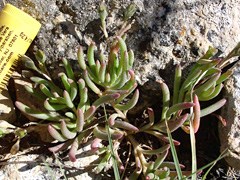
Tusayan flameflower (Phemeranthus validulus) only grows in a few areas in Coconino and Yavapai counties in northern Arizona, in and around Grand Canyon National Park. Tusayan flameflower is a rather inconspicuous plant, usually only up to an inch or two in diameter and one-half to three inches tall. 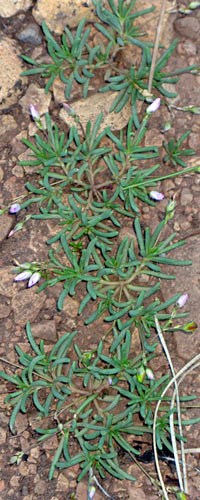
Tusayan flameflower is rare within Grand Canyon National Park, with approximately 1000 plants identified in 10 small populations. The plant’s unique habitat requirements—open areas with shallow rocky soils—limit its distribution in the park. Biological soil crust helps hold soil moisture and provides nutrients to these and other plants. The National Park Service is responsible for preserving and protecting all park resources—from the scenic splendor of canyon vistas to the rocks along park trails, from major archeological sites such as Tusayan Ruin to individual pot sherds, and from the majestic California condor to the miniscule Tusayan flameflower. Grand Canyon National Park’s Science and Resource Management staff plays a critical role in ensuring the preservation of park resources by conducting surveys for a variety of natural and cultural resources every time a project is conducted that could affect them. Surveys are done for rare or endangered plants, animals and cultural resources (including archeological sites) as part of every park construction project, including the implementation of the South Rim Visitor Transportation Plan. 
The South Rim Visitor Transportation Plan addresses the most pressing traffic, parking and visitor access issues in Grand Canyon Village. The objectives of the plan include accommodating current and anticipated future levels of visitation, enhancing visitor experiences, and protecting park resources. 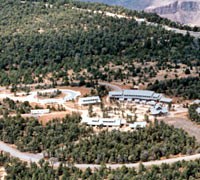
During the development of the South Rim Visitor Transportation Plan, park biologists conducted a complete survey of all plant species found in areas adjacent to Mather Point and CVIP in August 2007. Horticulturist Jan Busco and plant biologist Molly Boyter led the surveys that included a complete inventory of all vascular plant species, including both native and nonnative plants. The crew specifically searched for rare plant species including sentry milkvetch, and for Tusayan flameflower. While the vegetation crew confirmed the absence of sentry milkvetch in the Mather Point/CVIP area, it confirmed the presences of two subpopulations of Tusayan flameflower that had been found in previous surveys. The South Rim Visitor Transportation Plan requires that the park protect Tusayan flameflower plants in areas that will be impacted by parking lot and other visitor facility construction at CVIP. On August 12th and 13th 2008, park biologists salvaged plants from future construction zones and transplanted them in suitable habitat nearby. 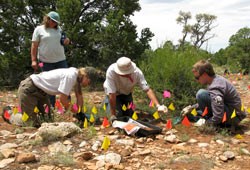
The vegetation crew consisting of Jan Busco, Ashton Bedford, Deon Ben, and volunteer Sara M. Griffith first located all Tusayan flameflower plants in the Mather Point/CVIP population. 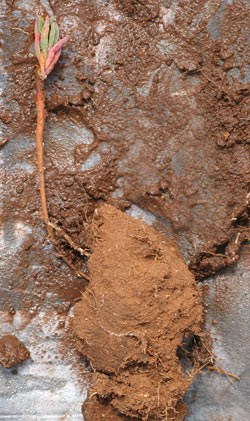
Busco said, “We found it really interesting to see the size and type of roots that these plants have. In the shallowest soils, the roots were essentially horizontal tubers. In deeper soils, there is a complex system of fine roots. Biologists will visit the translocated plants twice each week to monitor soil moisture and plant survival, and will water the plants if soil conditions are too dry. During transplanting, each individual plant was also tagged with a unique identification number that all allow biologists to track its survival. Park staff will also construct fences or low walls of stacked rocks around Tusayan flameflower populations prior to the start of construction in 2009 to further protect the plants. 
NPS PHOTOS BY MICHAEL QUINN Busco concluded, “I am excited that the flameflower transplant is complete. It is especially encouraging that it looks like we successfully timed this project so that these little botanical gems will receive abundant monsoonal rains to give them the best possible conditions to take root and thrive! Another important aspect of the flameflower project is that we will learn more about transplanting techniques for rare plants that grow in these shallow limestone soils. We hope to use information about transplanting techniques from this project to aid us in the restoration program for sentry milkvetch.” |
Last updated: September 16, 2023
